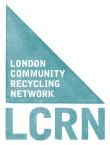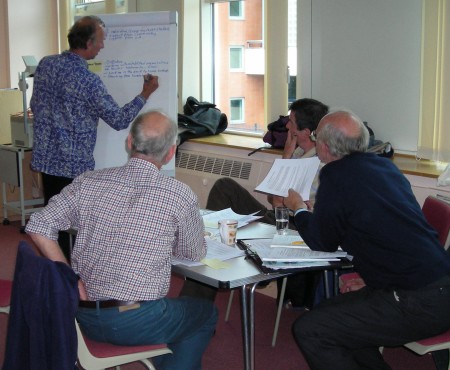Exercise 3: Impact Mapping
Purpose
The development of an Impact Map is a key stage in developing an evaluation framework for a community composting project.
The Impact Map identifies the most important stakeholders, the outcomes that they will be experiencing if the project is a success, as well as the steps that lead up to each outcome. With this information, it is possible to identify the best ways of knowing (indicators) that an outcome has happened (e.g. by tracking the steps, or observing the change at the end) and therefore the most appropriate way of collecting information to prove the project’s impact.
Preparation
Who to invite: Up to about 12 participants drawn from a selection of stakeholders who might be affected by or are able to affect the work of the project.
What to say to them: Invite participants saying that this is a formal scoping stage for the project’s planning and evaluation. They will be part of an exercise in which they will be identifying those outcomes that are central to the achievement of the project’s mission. Once the most important of these outcomes have been agreed, they will help decide the best ‘ways of knowing’ that outcomes are happening (choosing indicators), and offer practical advice from their own perspective of how such information might be collected to prove the project’s impact.
Role of facilitator: To welcome participants, guide them through the steps, keep them to time.
Materials needed: Chairs arranged around a completed Storyboard Poster (from Exercise 2) on the wall or flipchart, 2 flipchart stands, flipchart paper and marker pens.
When to use the exercise: Ideally at the start of a project, or new project cycle, or as part of a strategic review process. It forms the last part of a project evaluation scoping, and naturally leads on from the less formal Storyboard, Exercise 2.
Which tools work together: This exercise takes the description of the project outcomes outlined in the Storyboard Exercise to a more precise level of detail, by identifying which stakeholders benefit, and the ways of knowing that an outcome has been achieved.
Step by Step (Allow up to 60 minutes)
- Attach the completed Storyboard to the wall for all the workshop participants to see. Review the story it tells by attempting to follow the logical path from the immediate results (Box 3) to the medium-term outcomes (Box 4), to the longer-term and wider outcomes (Box 5) via the triangles (6 and 7).
- Make a long list of all the stakeholder groups (potential and actual beneficiaries) that are represented in the story.
- Prepare a template for an Impact Map by drawing a table with 5 columns on a horizontal flipchart sheet using the headings shown below. (Stakeholder, Activities, Outputs etc.) There is no need to write out the suggested definitions provided, although you could read them out to the group to help focus the discussion.
stakeholder activities outputs outcomes ways of knowing The potential and actual beneficiaries of the community composting project
(E.g. local residents, volunteers and workers, local businesses etc.)The things that you do to effect some sort of change in people, the community, or the environment.
(E.g. Providing a service, a programme, or a good to people. )The direct results for beneficiaries. Usually outputs show that certain people receive something, learn something, or take part in something as a result of what you do or how you do it.
(E.g. Easily observable or countable things, like the number of people involved, or the number of hours of training delivered etc.)Longer-term change. Describe why each output is important, in terms of the implications for, and the effect it has on, a local area or a group of people.
This is the theory that an evaluation will be testing—the link between what you do and the things you care passionately about.What will each stakeholder experience if a particular outcome is achieved? How will they (and we) know that it has happened?
(E.g. If an outcome is that the project improves community cohesion, one way of knowing is that project participants report that they have made new friends and contacts through their involvement.) - Now from your long list of stakeholder groups, select a shortlist of the four or five most important, and list them in the left hand column of the table.
- For each stakeholder, think through the logic for how the project’s specific activities and outputs (direct results) lead to a specific outcome for that particular stakeholder group. (Use the working definitions in each column to help decide where each piece of the story fits in).
- For each outcome, identify the most easily observable or recordable way of knowing that it has come about, and describe what this looks like in the final column of the Impact Map.
- These ‘ways of knowing’ represent a master list of the possible indicators you could use to prove the impact of the community composting project.
- For each of the ways of knowing that you have identified in the impact map decide which are the most important and the most feasible ways of collecting information that will inform your understanding of change taking place.
Postscript to Impact Mapping
For more details on how to refine your list of indicators, we suggest that you refer to the following two links:
- See the section called Develop Good Indicators, on the NEF's Proving and Improving website.
- See chapter 8 of the report "Prove It! Measuring the effects of neighbourhood renewal on local people" (available as a PDF document on the NEF website.
For ways of collecting information on specific indicators see the Links to other tools and approaches for measuring outcomes section of this website.
Printed from: www.valuingcommunitycomposting.org.uk
This website was developed as one of the deliverables for the Defra funded Open University research project, WR0211: Unlocking the Potential of Community Composting. Information contained in it is correct at the time of publication. © The Open University, January 2009




"We also need to work on changing public perception. This will only happen if people know what we do, because it is usually ignorance that causes the sniggers." Participant, Devon Workshop
"How great it was that you chose to work with Rotters for one of your round 2 stakeholder workshops. The organisation of the workshop was very well thought out, using the Storytelling – common themes." Rotters, Liverpool
"Breaking down all that Rotters is about into the Storyboard Template was extremely useful and a real eye opener in terms of how we can work more effectively within the local community." Rotters, Liverpool
"I really enjoyed Friday’s workshop… the methods used for measuring and discussion were excellent." Exeter Workshop Participant
